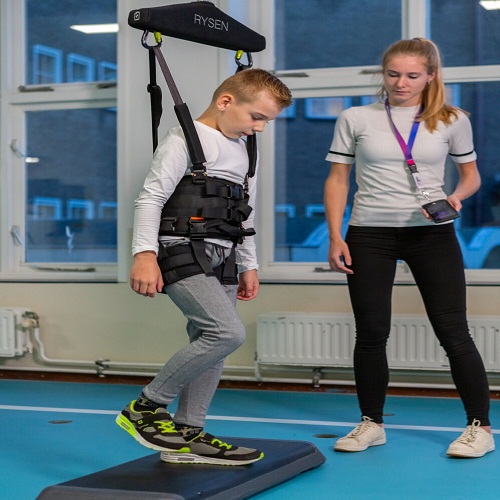Robotic body-weight support (BWS) devices can play a key role in helping people with neurological disorders to improve their walking. The team that developed the advanced body-weight support device RYSEN in 2018 has since gained more fundamental insight in BWS but also concludes that improvement in this field is necessary. They find that recommendations for the optimal therapy settings have to be customized to each device and that developers should be more aware of the interaction between patient and the device.
Stroke, spinal cord injury or other neurological disorders can lead to impairments that severely impact the quality of life. Intensive gait neurorehabilitation training can help these individuals regain mobility and lower the workload of revalidation therapists. This can be realized with so-called robotic body-weight support (BWS) devices. Examples of the latest generation of such robotic devices are the FLOAT and the RYSEN. One of their special features is the incorporation of adjustable support force in 3D.
The developers of the RYSEN have now evaluated their system and other BWS and have published their findings in Science Robotics. “Numerous studies have investigated the impact of BWS on gait patterns, and the results are less consistent than one would expect,” says prof. Heike Vallery of TU Delft. “We stress the importance of understanding the precise determinants, like the support force direction and the attachment points on the harness. Our paper investigates the exact influence of these and other factors on the production of gait.”
Backward force
“As this information is critical to the design of an optimal BWS, we systematically studied these determinants for the RYSEN. A very striking result that we found is that (healthy) subjects select a small backward force when asked for their preferred BWS conditions (where a forward force was expected). Moreover, we found that with this small backwards force, the gait characteristics were closer to normal walking than without the backwards force,” says Michiel Plooij, Mechatronic System Engineer TU Delft/DEMCON).
This unexpected finding challenges the view that during human-robot interactions, humans predominantly optimize energy efficiency. Instead, they might seek to increase their feeling of stability and safety. The researchers also demonstrate that the location of the attachment points on the harness strongly impacts gait patterns, while harness attachment is hardly reported in literature.
Customize
Plooij: “In general, we show that a lot of scientific questions remain. We developed the RYSEN foremost as a tool for studying and supporting gait rehabilitation. When we tried to replicate previous research on device settings on the RYSEN, we found that the same device settings as in previous research led to completely different outcomes.”
Despite using apparently similar systems, the scientific data obtained by the devices are not similar. Therefore, recommendations for the optimal therapy settings have to be customized to each device. Understanding the interaction between human and BWS devices is critical in the design and use of these devices.
Source: techxplore










